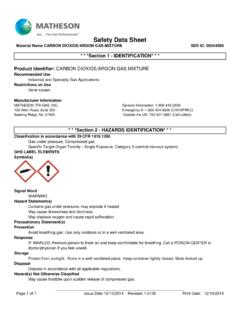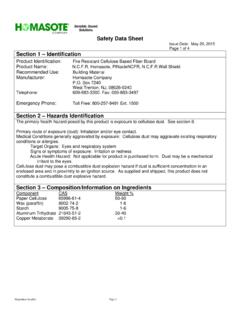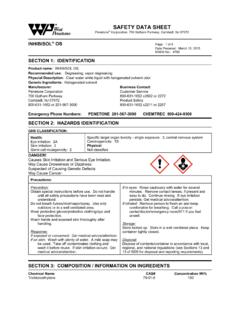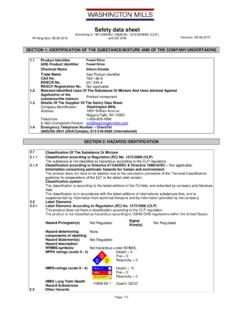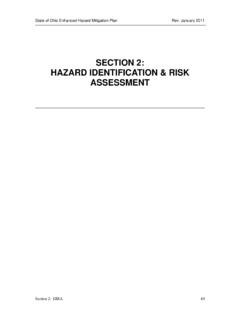Transcription of SECTION 2: HAZARDS IDENTIFICATION - E-ZOIL
1 E-ZOIL Products, Inc. Page 1 of 7 SAFETY DATA SHEET D-GEL SECTION 1: IDENTIFICATION Product Name: D-Gel Product Code: F10 Product Use: Diesel additive Manufacturer's Name: E-ZOIL Products, Inc. Address: 234 Fillmore Avenue Address: Tonawanda, NY 14150 USA Business Phone: 855-693-9645 Emergency Phone: 800-633-8253 PERS Date of Preparation: October 1, 2015 Date of Last Revision: October 1, 2015 Regulatory Standard: CFR29 HazCom 2012 SECTION 2: HAZARDS IDENTIFICATION GHS-US classification Flammable Liquid 3 Skin Irritation 2 Eye Irritation 2A Specific target organ toxicity Single exposure 3 Aspiration toxicity 1 Hazard pictograms (GHS-US): Signal word (GHS-US): Danger Hazard statements (GHS-US): Flammable liquid and vapor.
2 Causes skin irritation. Causes serious eye irritation. May cause drowsiness or dizziness. May be fatal if swallowed and enters airways. Precautionary statements (GHS-US): Keep away from heat/sparks/open flames/hot surfaces. No smoking. Keep container tightly closed. Ground/Bond container and receiving equipment. Use explosion-proof electrical/ ventilating/lighting/equipment. Use only non-sparking tools. Take precautionary measures against static discharge. Wash hands thoroughly after handling. Obtain special instructions before use. Do not handle until all safety precautions have been read and understood. Wear protective gloves/protective clothing/eye protection/face protection. Avoid breathing dust/fume/gas/mist. If exposed or concerned: Get medical advice/attention.
3 If on skin (or hair): Take off immediately all contaminated clothing and wash before reuse. Rinse skin with water/shower. If skin irritation occurs: Get medical advice/attention. If in eyes: Rinse cautiously with water for several minutes. Remove contact lenses, if present and easy to do. Continue rinsing. If eye irritation persists: Get medical advice/ attention. If inhaled: Remove person to fresh air and keep comfortable for breathing. Call a poison center/doctor if you feel unwell. If swallowed: Immediately call a poison center/doctor. Do NOT induce vomiting. Store in a well- ventilated place. Keep cool. Store locked up. Keep container tightly closed. Dispose of contents/container in accordance with local, regional, national and international regulations.
4 Other information: None. SECTION 3: COMPOSITION/INFORMATION ON INGREDIENTS E-ZOIL Products, Inc. Page 2 of 7 Name CAS Number % Solvent naphtha, petroleum, light aromatic 64742-95-6 40 - 70 Ethylene glycol butyl ether 111-76-2 10 - 30 Isopropyl alcohol 67-63-0 10 - 30 The exact percentage (concentration) of composition has been withheld as a trade secret in accordance with paragraph (i) of SECTION 4: FIRST AID MEASURES First-aid measures after inhalation: If inhaled, remove to fresh air. If not breathing, give artificial respiration. If breathing is difficult, give oxygen. Get immediate medical advice/attention. First-aid measures after skin contact: In case of contact, immediately flush skin with plenty of water.
5 Remove contaminated clothing and shoes. Wash clothing before reuse. Call a physician if irritation develops and persists. First-aid measures after eye contact: In case of contact, immediately flush eyes with plenty of water for at least 15 minutes. If easy to do, remove contact lenses, if worn. If irritation persists, get medical attention. First-aid measures after ingestion: If swallowed, do NOT induce vomiting. Immediately call a POISON CENTER or doctor/physician. Never give anything by mouth to an unconscious person. Most important symptoms and effects, both acute and delayed: Symptoms/injuries after inhalation: May cause respiratory tract irritation. May cause drowsiness or dizziness. Symptoms/injuries after skin contact: Causes skin irritation.
6 Symptoms may include redness, edema, drying, defatting and cracking of the skin. Symptoms/injuries after eye contact: Causes serious eye irritation. Symptoms may include discomfort or pain, excess blinking and tear production, with marked redness and swelling of the conjunctiva. Symptoms/injuries after ingestion: May be fatal if swallowed and enters airways. This product may be aspirated into the lungs and cause chemical pneumonitis. May cause stomach distress, nausea or vomiting. Indication of any immediate medical attention and special treatment needed: Symptoms may not appear immediately. In case of accident or if you feel unwell, seek medical advice immediately (show the label or SDS where possible). SECTION 5: FIRE FIGHTING MEASURES Suitable extinguishing media: Foam.
7 Dry chemical. Carbon dioxide. Unsuitable extinguishing media: None known. E-ZOIL Products, Inc. Page 3 of 7 Fire hazard: Flammable liquid and vapor. Products of combustion may include, and are not limited to: oxides of carbon. Explosion hazard: May form flammable/explosive vapor-air mixture. Protection during firefighting: Keep upwind of fire. Wear full firefighting turn-out gear (full Bunker gear) and respiratory protection (SCBA). Vapors may be heavier than air and may travel along the ground to a distant ignition source and flash back. Use water spray to keep fire-exposed containers cool. SECTION 6: ACCIDENTAL RELEASE MEASURES General measures: Use personal protection recommended in SECTION 8. Isolate the hazard area and deny entry to unnecessary and unprotected personnel.
8 Eliminate sources of ignition. For containment: Contain and/or absorb spill with inert material ( sand, vermiculite), then place in a suitable container. Do not flush to sewer or allow to enter waterways. Use appropriate Personal Protective Equipment (PPE). Methods for cleaning up: Scoop up material and place in a disposal container. Provide ventilation. See SECTION 8 for further information on protective clothing and equipment and SECTION 13 for advice on waste disposal. SECTION 7: HANDLING AND STORAGE Additional HAZARDS when processed: Handle empty containers with care because residual vapors are flammable. Precautions for safe handling: Keep away from sources of ignition - No smoking. Take precautionary measures against static discharge.
9 Use only non-sparking tools. Use only outdoors or in a well-ventilated area. Avoid contact with skin and eyes. Avoid breathing dust/fume/gas/mist/vapors/spray. Do not swallow. Handle and open container with care. When using do not eat, drink or smoke. Hygiene measures: Launder contaminated clothing before reuse. Wash hands before eating, drinking, or smoking. Technical measures: Proper grounding procedures to avoid static electricity should be followed. Storage conditions: Keep out of the reach of children. Store in original container protected from direct sunlight in a dry, cool and well-ventilated area. Keep container tightly closed when not in use. Storage temperature: 39 120 F SECTION 8: EXPOSURE CONTROLS/PERSONAL PROTECTION Solvent naphtha, petroleum, light aromatic (64742-95-6) ACGIH Not applicable OSHA Not applicable E-ZOIL Products, Inc.
10 Page 4 of 7 Ethylene glycol butyl ether (111-76-2) ACGIH ACGIH TWA (ppm) 20 ppm OSHA OSHA PEL (TWA) (mg/m ) 240 mg/m OSHA OSHA PEL (TWA) (ppm) 50 ppm Isopropyl alcohol (67-63-0) ACGIH ACGIH TWA (ppm) 200 ppm ACGIH ACGIH STEL (ppm) 400 ppm OSHA OSHA PEL (TWA) (mg/m ) 980 mg/m OSHA OSHA PEL (TWA) (ppm) 400 ppm Appropriate engineering controls: Use ventilation adequate to keep exposures (airborne levels of dust, fume, vapor, etc.) below recommended exposure limits. Hand protection: Wear chemically resistant protective gloves. Eye protection: Wear safety glasses with side shields or goggles. Skin and body protection: Wear suitable protective clothing. Respiratory protection: In case of insufficient ventilation, wear suitable respiratory equipment.


